COOKER PARTS DETAILS.
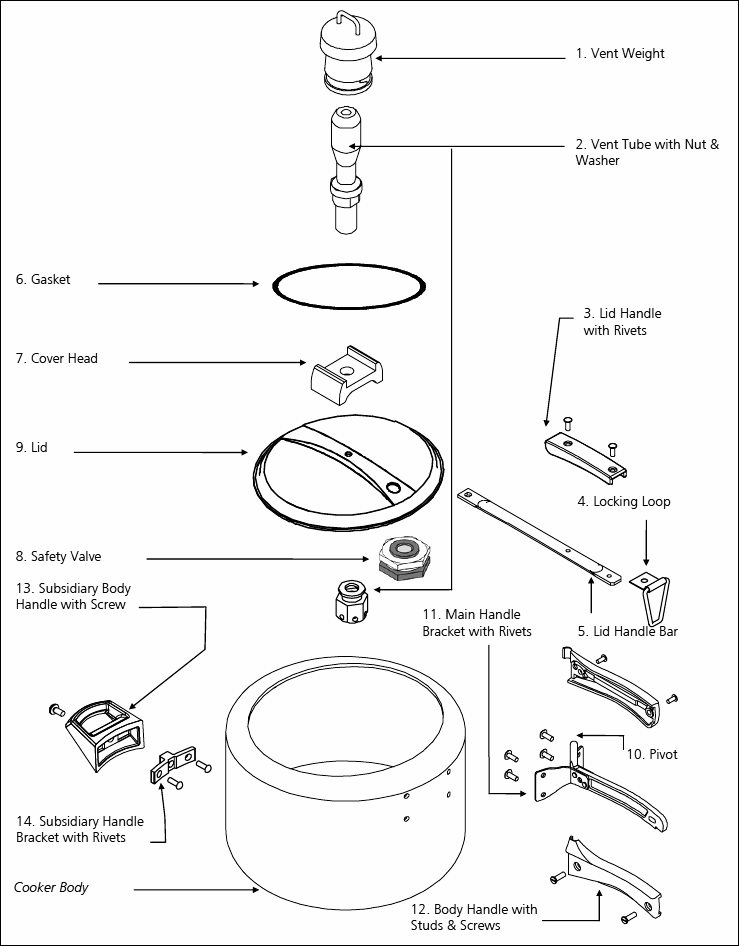
Do-it-Yourself Repairs
Note: Do not attempt to make any changes to the vent weight and safety valve. Repairs fother than the replacement of gasket, body handles, safety valve and the vent weight must be done only by an Authorised Service Centre/representative. All replacement parts must be genuine SARAL parts.
In case you have to replace certain SARAL cooker parts yourself, you will find the notes below helpful.
Sealing Ring Replacement
If leakage develops along the rim of the cooker body which is not due to the misalignment of the lid or a dent on the rim or lid curl, the sealing ring needs to be replaced. This is simply done by changing it with a replacement SARAL sealing ring.
Replacement of Plastic Handles
The subsidiary handle and the body handle are replaceable by unscrewing the existing handle and screwing on the replacement handle with a screwdriver. For the body handle: place the two halves of plastic body handle on either side of the metal bracket. Join them together, insert studs and tighten the screws into studs from the opposite side.
If the subsidiary or the body handle is difficult to unscrew, a second person holding the cooker body firmly while one person turns the handle screws anti-clockwise will make it easier.
Safety Valve Replacement
1. Get a genuine SARAL safety valve.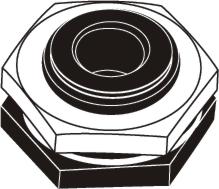
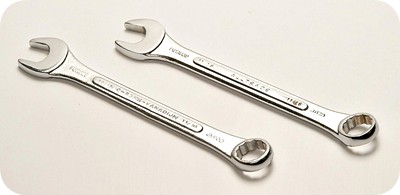
2. Two 19mm/3/4 inch spanners (wrenches) are required to replace the safety valve – one for holding the valve on the underside of the lid and one for turning the nut on the top of the lid.
3. A food compatible sealant or glue is recommended.
4. One strong person can replace the safety valve as stated below.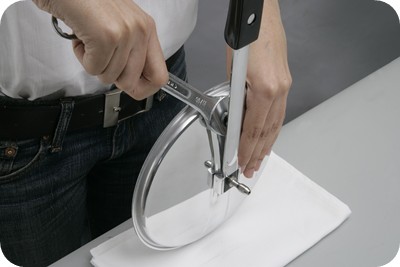
TO REMOVE
1. Remove the sealing ring and pressure regulator from the lid.
2. Hold and brace the lid on a soft surface such as a folded cloth with the left hand. Take care not to bend or warp the lid curl. Do not hold the lid by the handle. With the right hand, place the spanner around the nut on the top of the lid (see Picture alongside). Exert downward pressure on the nut just until it loosens.
3. Place the ring end of one spanner on the valve on the underside of the lid and hold it in place with the thumb of the left hand while grasping the lid with the same hand (see Picture 2). With the right hand, place the other spanner around the nut on the top of the lid (see Picture 3). Exert downward pressure on the nut. Remove and re-apply spanner to the nut on the top of the lid at a higher angle. Repeat downward pressure. Repeat procedure until the nut can be unscrewed from valve with fingers. Remove nut, washer and valve. A factory-fitted safety valve does not include a washer. Discard all parts; do not reuse any part.
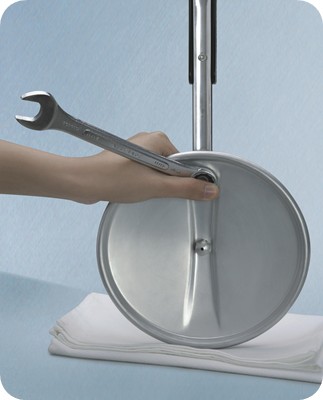
Picture 2 
Picture 3
TO REPLACE
1. Clean all surfaces around the lid hole where the safety valve will sit.
2. Unscrew the new nut and remove the washer and keep them to one side, with the chamfered side of the nut up.

3. Hold the valve and apply a small amount of food compatible sealant or glue on the valve threads (to prevent any leakage). Push the valve into the safety valve hole from the underside of the lid and hold in place with the left hand. Place the washer around the threads of the valve on the top surface of the lid. Place the nut (chamfered side up) on the washer and screw the nut in a clockwise direction with your fingers until tight (see Picture 4).
4. Wipe off any sealant or glue that may have squeezed out while it is still fresh and soft.
5. Hold the lid handle in your right hand and turn the lid upside down, that is, with the underside of the lid facing you and the top side of the lid lying flat on the soft, folded cloth on a table. With the left hand, position the ring end of one spanner around the valve on the underside of the lid and hold it in place with the fingers of the left hand while grasping the lid with the same hand (see Picture 5).
6. Raise the lid vertically, holding the lid with your left hand with the ring spanner in place on the safety valve (to stop its rotation when you tighten the nut). Now the underneath of the lid will be away from you and the top of the lid will be facing you. With the right hand, position the second spanner around the nut under the lid handle bar at an upward angle and exert downward pressure on the spanner (see Picture 6). Tighten the nut securely by repeating the downward strokes of the spanner until the nut stops moving. 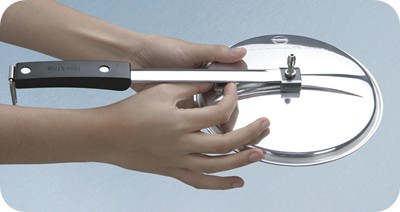
Picture 4
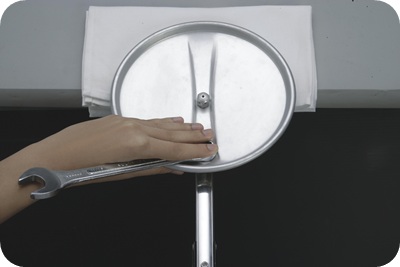
Picture 5
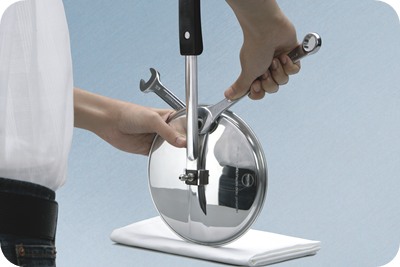
Picture 6
Note: Do not attempt to make any changes to the vent weight and safety valve. Repairs fother than the replacement of gasket, body handles, safety valve and the vent weight must be done only by an Authorised Service Centre/representative. All replacement parts must be genuine SARAL parts. In case you have to replace certain SARAL cooker parts yourself, you will find the notes below helpful. | |
Sealing Ring Replacement If leakage develops along the rim of the cooker body which is not due to the misalignment of the lid or a dent on the rim or lid curl, the sealing ring needs to be replaced. This is simply done by changing it with a replacement SARAL sealing ring. Replacement of Plastic HandlesThe subsidiary handle and the body handle are replaceable by unscrewing the existing handle and screwing on the replacement handle with a screwdriver. For the body handle: place the two halves of plastic body handle on either side of the metal bracket. Join them together, insert studs and tighten the screws into studs from the opposite side. If the subsidiary or the body handle is difficult to unscrew, a second person holding the cooker body firmly while one person turns the handle screws anti-clockwise will make it easier. Safety Valve Replacement1. Get a genuine SARAL safety valve. | |
 |  |
2. Two 19mm/3/4 inch spanners (wrenches) are required to replace the safety valve – one for holding the valve on the underside of the lid and one for turning the nut on the top of the lid. 3. A food compatible sealant or glue is recommended. 4. One strong person can replace the safety valve as stated below. | |
 TO REMOVE 1. Remove the sealing ring and pressure regulator from the lid. 2. Hold and brace the lid on a soft surface such as a folded cloth with the left hand. Take care not to bend or warp the lid curl. Do not hold the lid by the handle. With the right hand, place the spanner around the nut on the top of the lid (see Picture alongside). Exert downward pressure on the nut just until it loosens. 3. Place the ring end of one spanner on the valve on the underside of the lid and hold it in place with the thumb of the left hand while grasping the lid with the same hand (see Picture 2). With the right hand, place the other spanner around the nut on the top of the lid (see Picture 3). Exert downward pressure on the nut. Remove and re-apply spanner to the nut on the top of the lid at a higher angle. Repeat downward pressure. Repeat procedure until the nut can be unscrewed from valve with fingers. Remove nut, washer and valve. A factory-fitted safety valve does not include a washer. Discard all parts; do not reuse any part. | |
 Picture 2 |  Picture 3 |
TO REPLACE 1. Clean all surfaces around the lid hole where the safety valve will sit. 2. Unscrew the new nut and remove the washer and keep them to one side, with the chamfered side of the nut up. |  |
| 3. Hold the valve and apply a small amount of food compatible sealant or glue on the valve threads (to prevent any leakage). Push the valve into the safety valve hole from the underside of the lid and hold in place with the left hand. Place the washer around the threads of the valve on the top surface of the lid. Place the nut (chamfered side up) on the washer and screw the nut in a clockwise direction with your fingers until tight (see Picture 4). 4. Wipe off any sealant or glue that may have squeezed out while it is still fresh and soft. 5. Hold the lid handle in your right hand and turn the lid upside down, that is, with the underside of the lid facing you and the top side of the lid lying flat on the soft, folded cloth on a table. With the left hand, position the ring end of one spanner around the valve on the underside of the lid and hold it in place with the fingers of the left hand while grasping the lid with the same hand (see Picture 5). 6. Raise the lid vertically, holding the lid with your left hand with the ring spanner in place on the safety valve (to stop its rotation when you tighten the nut). Now the underneath of the lid will be away from you and the top of the lid will be facing you. With the right hand, position the second spanner around the nut under the lid handle bar at an upward angle and exert downward pressure on the spanner (see Picture 6). Tighten the nut securely by repeating the downward strokes of the spanner until the nut stops moving. |  Picture 4  Picture 5  Picture 6 |
Do-it-Yourself Repairs
Note: Do not attempt to make any changes to the vent weight and safety valve. Repairs fother than the replacement of gasket, body handles, safety valve and the vent weight must be done only by an Authorised Service Centre/representative. All replacement parts must be genuine SARAL parts.
In case you have to replace certain SARAL cooker parts yourself, you will find the notes below helpful.
Sealing Ring Replacement
If leakage develops along the rim of the cooker body which is not due to the misalignment of the lid or a dent on the rim or lid curl, the sealing ring needs to be replaced. This is simply done by changing it with a replacement SARAL sealing ring.
Replacement of Plastic Handles
The subsidiary handle and the body handle are replaceable by unscrewing the existing handle and screwing on the replacement handle with a screwdriver. For the body handle: place the two halves of plastic body handle on either side of the metal bracket. Join them together, insert studs and tighten the screws into studs from the opposite side.
If the subsidiary or the body handle is difficult to unscrew, a second person holding the cooker body firmly while one person turns the handle screws anti-clockwise will make it easier.
Safety Valve Replacement
1. Get a genuine SARAL safety valve.
2. Two 19mm/3/4 inch spanners (wrenches) are required to replace the safety valve – one for holding the valve on the underside of the lid and one for turning the nut on the top of the lid.
3. A food compatible sealant or glue is recommended.
4. One strong person can replace the safety valve as stated below.




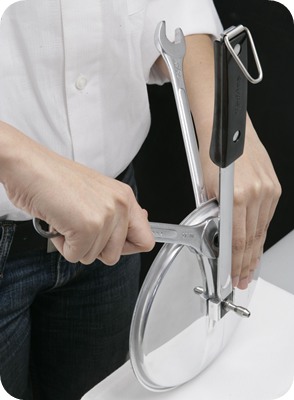
TO REMOVE
1. Remove the sealing ring and pressure regulator from the lid.
2. Hold and brace the lid on a soft surface such as a folded cloth with the left hand. Take care not to bend or warp the lid curl. Do not hold the lid by the handle. With the right hand, place the spanner around the nut on the top of the lid (see Picture alongside). Exert downward pressure on the nut just until it loosens.
3. Place the ring end of one spanner on the valve on the underside of the lid and hold it in place with the thumb of the left hand while grasping the lid with the same hand (see Picture 2). With the right hand, place the other spanner around the nut on the top of the lid (see Picture 3). Exert downward pressure on the nut. Remove and re-apply spanner to the nut on the top of the lid at a higher angle. Repeat downward pressure. Repeat procedure until the nut can be unscrewed from valve with fingers. Remove nut, washer and valve. A factory-fitted safety valve does not include a washer. Discard all parts; do not reuse any part.
TO REPLACE
1. Clean all surfaces around the lid hole where the safety valve will sit.
2. Unscrew the new nut and remove the washer and keep them to one side, with the chamfered side of the nut up.
3. Hold the valve and apply a small amount of food compatible sealant or glue on the valve threads (to prevent any leakage). Push the valve into the safety valve hole from the underside of the lid and hold in place with the left hand. Place the washer around the threads of the valve on the top surface of the lid. Place the nut (chamfered side up) on the washer and screw the nut in a clockwise direction with your fingers until tight (see Picture 4).
4. Wipe off any sealant or glue that may have squeezed out while it is still fresh and soft.
5. Hold the lid handle in your right hand and turn the lid upside down, that is, with the underside of the lid facing you and the top side of the lid lying flat on the soft, folded cloth on a table. With the left hand, position the ring end of one spanner around the valve on the underside of the lid and hold it in place with the fingers of the left hand while grasping the lid with the same hand (see Picture 5).
6. Raise the lid vertically, holding the lid with your left hand with the ring spanner in place on the safety valve (to stop its rotation when you tighten the nut). Now the underneath of the lid will be away from you and the top of the lid will be facing you. With the right hand, position the second spanner around the nut under the lid handle bar at an upward angle and exert downward pressure on the spanner (see Picture 6). Tighten the nut securely by repeating the downward strokes of the spanner until the nut stops moving.




